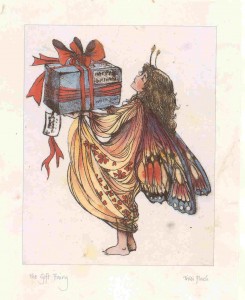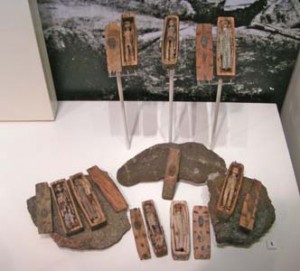Fairy Gifts October 2, 2011
Author: Beach Combing | in : Medieval, Modern , trackback***This post is dedicated to Invisible***
Beachcombing has sometimes lamented in this place the passing of the fairy faith be that in Essex, the Isle of Man or Yorkshire. How refreshing then to learn that in one corner of Europe the locals still walk in terror of the little folk. Beachcombing refers, of course, to the town of Bolgunjarvik in north-western Iceland where a couple of months ago the fairies were reportedly bombarding the community with rocks and soil in revenge for some inconsiderate dynamiting! Readers will be glad to hear that fairy mediators have been sent in to restore human-fairy relations.
This set Beachcombing thinking of a rare subcategory of the fairy faith, what might be called ‘fairy gifts’: shoes, clothes, flags and other treasures from under the sidh hills.
Beach starts in Iceland itself with the textile named: ‘The fairy woman’s cloth of Burstafjall’. He can do no better than quote Invisible who wrote in some months ago about this extraordinary object:
According to legend, the wife of the district police superintendent and public prosecutor at the farm of Burstafjall in Vopnafjordur in the east of Iceland , received this cloth as payment from a fairy woman whom she had midwifed. The cloth is now in the National Museum in Rekjavik. Thor Magnusson, who is the president’s Custodian of Antiquities says, ‘Certainly it’s a unique cloth, but it often happened in the old days that if people did not remember, or could not explain, the true origin of a rare item, they claimed that fairies had made it.’ [Sydvenska Dagbladet Snallposten 5 August 1984].
It would be lovely to find a picture of this object.

There are some other ‘gifts’ too up and down the Atlantic coast of Europe including Beachcombing’s favourite manifestation of fairy, the flag of MacLeod (pictured above), kept today at Dunvegan Castle. Textile experts long ago spoilt the fun pronouncing that the flag is made of silk and that as such it has an eastern origin: perhaps it was a gift brought back from the crusades? Again there is an object of forgotten origins, explained by magic. But in the fifteenth and sixteenth centuries the flag was believed to bring luck to the clan and one member of the Clan MacLeod even brought a picture of the flag on bombing raids in the Second World War…
The most famous object south of the border is probably the Luck of Eden Hall, a cup that was won from the fairies by a member of the Musgrove family ‘before records began’ and that today stands, intact, in the Victoria and Albert Museum. The cup, which is astoundingly beautiful, is supposed to be of ‘eastern origin’: crusades again anyone?
Beachcombing was going to mount a desperate attempt in defence of this particular object but he then learnt that the letters IHS are embossed on the casing (pictured). Fairies are many things, but church-goers they are most certainly not.
There are also, of course, Neolithic arrow heads that used to be known as ‘fairy arrows’ and that were blamed for various cattle illnesses when discovered out in the fields.
Then Invisible who deserves the credit for almost all of the material gathered here came across a fairy shoe from Ireland:
(134) It was found by a farm labourer on the Beara Peninsula, south-west Ireland, in 1835. It is black, worn at the heel and styled like that of an eighteenth-century gentleman. But it is also only two and seven-eights inches long and seven-eights of an inch at its widest – too long and narrow even for a doll’s shoe. If it were an apprentice piece, say, how did it come to be found on a remote sheep track? Why was it made in the style of the previous century? Why is it such an odd shape? How did it come to be worn?… The man who found the shoe assumed it belonged to the ‘little people’ and gave it to the local doctor, from whom it passed to the Sommerville family of Castletownshend, County Cork. On a lecture tour of America, the author Dr. Edith Sommerville. gave the shoe to Harvard University scientists, who examined it minutely. The shoe had tiny hand-stitches and well-crafted eyelets (but no laces), and ‘was thought to be’ of mouse skin.
Beach ran across the following reference in a nineteenth-century book. He would KILL and PAY for an advert and described from a nineteenth-century Irish newspaper.
Are you aware that, on this side of the channel [i.e in Ireland], we have so little doubt of the existence of fairies, that it is no uncommon occurrence to see shoes of fairy manufacture publicly advertised in the newspapers? If I tell you, that while crossing a field, in the purple light of the morning, the attention of a peasant was arrested by the sound of a shoemaker’s hammer; and that, upon leaving the path to discover the cause, he disturbed an elfin cobbler, who it seems was at his trade betimes, and mending his brogues by the side of the ditch ; that the spirit of the air, anxious to escape from the prying eyes of mortal wight, leapt from the bank, and, in his haste, dropped both shoe and hammer: if I go on to tell you, that this story is most gravely related, and that the editor informs the public, that both shoe and hammer were carried to such a house, in such a street, in a certain town, in the county of Roscommon, and may there be viewed by any curious or incredulous persons; you will, I think, acknowledge that my tale has at least a better foundation than many which are related to our disadvantage, and but too readily swallowed by the credulity of our English friends.
A final reference – though there must be many, many more out there: drbeachcombing AT yahoo DOT com – might be to the fairy coffins found on Arthur’s Seat in Edinburgh in 1836. Beachcombing would like to see someone trying ‘the crusades’ on these bizarre relics: Lothian voodoo would be Beach’s guess.





